
Unless you’re using a tankless water heater, you likely experience a delay in receiving hot water when you turn on your faucet or shower. Often times, we let that initial cold water down the drain until the hot water makes its way to the fixture. Over time, this wasted water can really add up.
One way you can speed up the process and receive nearly instant hot water is to install a hot water recirculating pump. So what is a hot water recirculating pump and what are the benefits of installing one?
How does a hot water recirculating pump work?
In a typical plumbing system, hot water is sent from your water heater to the tap. When that tap is shut off, the water that was sent cools down in the pipes. The next time you turn on a tap, you have to wait for the water to heat up again before you receive the hot water you desire.
With a hot water recirculating pump, that cooled-down water is sent back to the water heater via the cold water line and reheated. A small amount of hot water is consistently pumped throughout your pipes all the way from your water heater to the furthest fixture in your piping system and back again. This significantly reduces the amount of time you have to wait for hot water.
What are the benefits of installing a hot water recirculating pump?
The average household wastes between 10,000 and 20,000 gallons of water per year waiting for hot water. By installing a hot water recirculating pump, you can significantly cut back on your home’s water consumption and even reduce your water bills.
Although more energy is used when operating a hot water recirculating pump, you can control how and when it’s used by choosing a model with a built-in timer and/or a pump that can be temperature-controlled.
If you have any questions about a hot water recirculating pump, or if you’d like one installed in your home, contact Cabrillo, your San Francisco area plumbing, heating and cooling company. We service the San Francisco area and surrounding cities like Redwood City, Daly City, Orinda and Mountain View.
